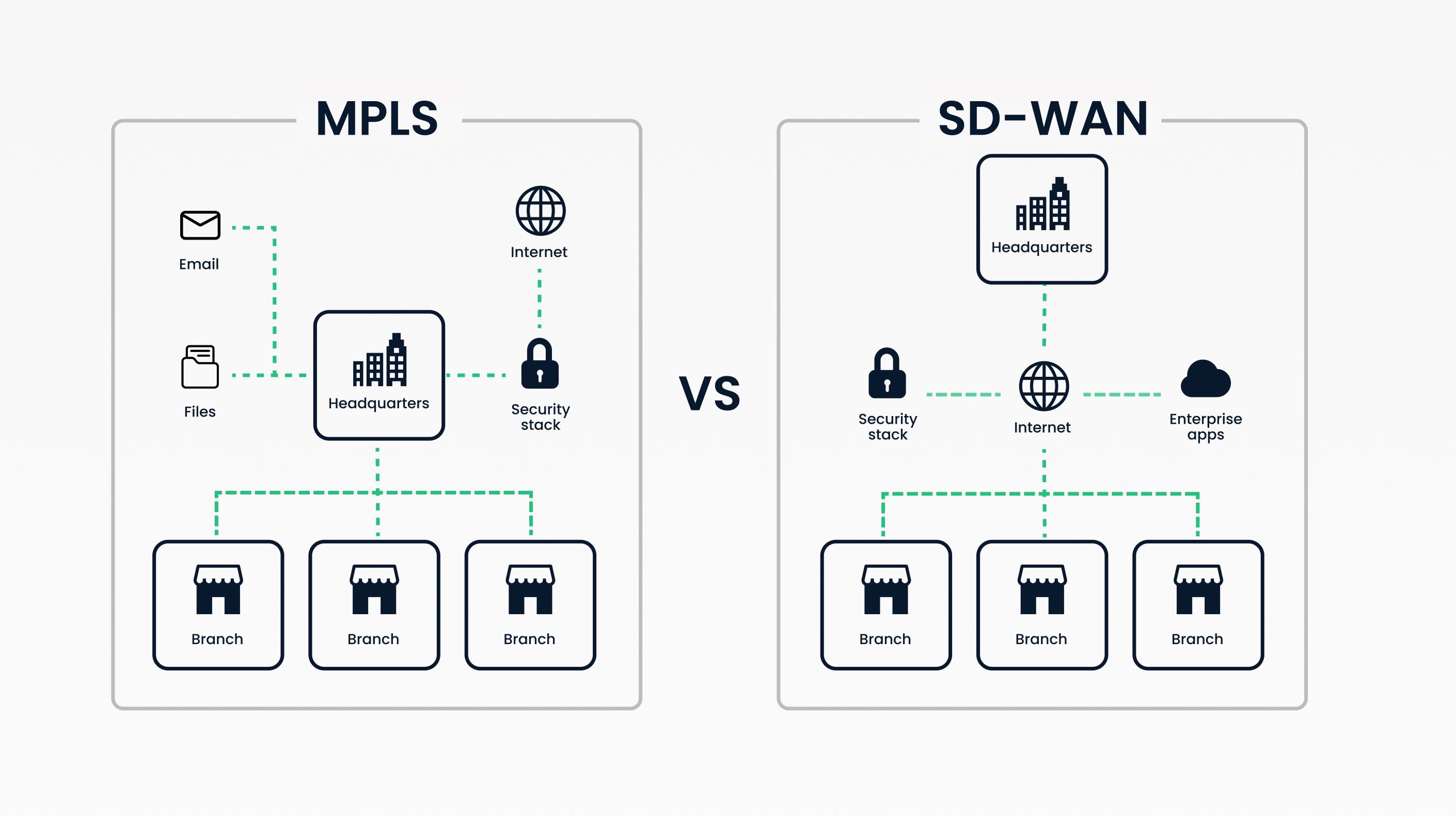Also in this category
View more in SD-WAN & WANSD-WAN & WAN
SD-WAN is the next-generation evolution of MPLS

Multiprotocol Label Switching (MPLS) is a well-established technology that has been used for decades to connect branch offices to a private network. It uses fixed circuits leased from a service provider for a highly reliable and secure connection. By using physical routers and creating a direct path between connected locations, MPLS can enhance network performance and reduce latency.
However, MPLS has been more of a necessary evil than an asset, as the technology is expensive and inflexible. When remote work was infrequent and largely limited to one or two branch offices and MPLS was effectively the only option, it was often worth the investment.
This is no longer the case. Enterprises need considerably more flexible options for remote work than what MPLS can support, which is where the more advanced software-defined wide area network (SD-WAN) comes in.

SD-WAN builds on MPLS and other technologies
SD-WAN is a newer technology that uses software and cloud-based technology to route traffic across different connections, including MPLS circuits, broadband internet, and even 5G/LTE connections.
An SD-WAN virtualizes the network and separates the traffic decision-making process (control plane) from the traffic forwarding process (data plane). As a result, instead of sending all network traffic through a single hub, SD-WAN can dynamically and intelligently route traffic to the optimal path based on availability, bandwidth, and latency.
This offers numerous benefits for any organization planning to deploy a WAN to support multiple branch locations and remote workers.
Learn more about SD-WAN solutionsSimplified structure makes SD-WAN flexible and scalable
One of the most significant benefits of an SD-WAN is its superior flexibility and scalability. This is especially important for organizations with multiple branch offices or data centers, as traditional networking solutions can be challenging to scale and manage.
With an SD-WAN, organizations can easily add or remove locations as needed, without the hassle and cost of setting up new MPLS circuits. SD-WANs also offer the ability to scale bandwidth based on need. This makes it easier to adapt the network to changes in the market while avoiding network disruptions.
This flexibility and scalability make it easier to fit the network to business needs. As an organization grows, its network can grow and adapt with it. SD-WANs can easily handle increasing traffic and demand, providing seamless connectivity for all users. This scalability is crucial in today's fast-paced business world, where organizations need to be agile to adapt quickly to new challenges and opportunities.
Superior bandwidth and optimized connectivity
SD-WAN also offers improved connectivity and bandwidth compared to traditional MPLS technology. By using a combination of connections, SD-WAN can provide faster speeds and quality of service (QoS). This is particularly beneficial for real-time applications, such as VoIP or video conferencing, which require low latency and minimal packet loss.
Learn more about Quality of ServiceSD-WAN also provides enhanced optimization capabilities by making it easier to centralize all network traffic routing through a single data center or public cloud, as needed. Centralization improves performance and reduces packet loss by eliminating the need for backhauling, whereby remote traffic is sent over the internet to the data center and then back out to the internet.
Lower maintenance, management, and deployment costs
An SD-WAN can also improve network performance while reducing costs. One of the key reasons for this is that SD-WAN eliminates the need for expensive hardware installations. Rather than dedicated routers and switches at each branch location, an SD-WAN uses software to manage virtualized networks. This significantly reduces capital investment costs and ongoing maintenance needs.
In addition, SD-WAN makes more efficient use of bandwidth through dynamic load balancing and traffic prioritization. Coupled with the reduced management and maintenance costs due to its centralized management capabilities, SD-WAN becomes a more cost-effective solution for organizations of all sizes.
The lower deployment, maintenance, and management costs make SD-WAN a preferred option for organizations looking to expand their operations, especially in remote or international locations.
Greater reliability thanks to failback capabilities
Another crucial capability of SD-WAN is seamless and automatic failover of traffic in the event of a network issue or outage. This is achieved using multiple connections, such as broadband internet, MPLS, or 4G/LTE, which are all managed and monitored by the SD-WAN controller. If one connection experiences high latency, packet loss, or goes offline, the controller can quickly redirect traffic to another available connection.
SD-WAN offers both active-passive and active-active failover capabilities. In an active-passive configuration, the primary connection handles all network traffic, and the secondary connection only comes into play when the primary connection fails. Active-active failover is a more advanced approach, where both connections are used simultaneously, and network traffic is intelligently distributed to optimize performance and reliability.
Learn more about failover solutionsBuilt-in and centrally managed security functions
Another significant difference between SD-WAN and MPLS is in the level of security and control provided.
MPLS networks are entirely controlled and managed by a service provider, whereas SD-WANs provide organizations with more direct control over their network. Organizations can implement a variety of security measures, such as firewalls, VPNs, and zero-trust access networks (ZTNA) to enhance the security of their network and internet connections.
SD-WAN also allows for secure connections between branch offices and data centers, as well as connections to cloud-based applications and resources. By using advanced encryption techniques and security protocols, SD-WAN ensures that all network traffic remains secure and encrypted, even when traveling over public internet connections.
Another security benefit of SD-WAN is its ability to segment network traffic and apply different security levels to different applications or users. This granular level of control ensures that sensitive data and applications are protected while maintaining secure connectivity for all other users.
Inseego offers industry-leading SD-WAN solutions
Inseego empowers organizations to build a robust and scalable network infrastructure through our SD-WAN solutions. Whether you need secure connections between branch offices, data centers, or cloud applications, we provide cost-effective, high-performance hardware (cellular routers) and software (cloud device management) tailored to your specific requirements.
With our expertise in SD-WAN architecture and optimization, we can ensure your organization is always connected and running at its best.
Contact us today to learn more about our SD-WAN solutions.
Do you currently have a failover solution?
What are you using for failover?
Cellular provides a superior failover option compared to cable
Cellular provides a superior failover option compared to fiber
Cellular provides a superior failover option compared to satellite
Are you interested in using cellular for failover instead?
Cellular is an ideal failover solution for businesses
Are you interested in using cellular as failover for your business?
Besides failover, are you interested in using cellular for flexible or temporary internet?
Even if temporary internet isn’t a focus, would you be interested in using cellular for cost-effective scalability?
Here's some resources
Here's the solution for failover!
Here's a cost-effective solution!
Here's the solution for temporary internet!
What are your details?
How can we contact you?















Did you know?
Our hugely experienced team are located across the USA.
We’ll connect you with the Inseego team member nearest to you.
What happens next?
We aim to contact you via email within 1 business day to arrange a suitable to time for a detailed discussion of your needs.










